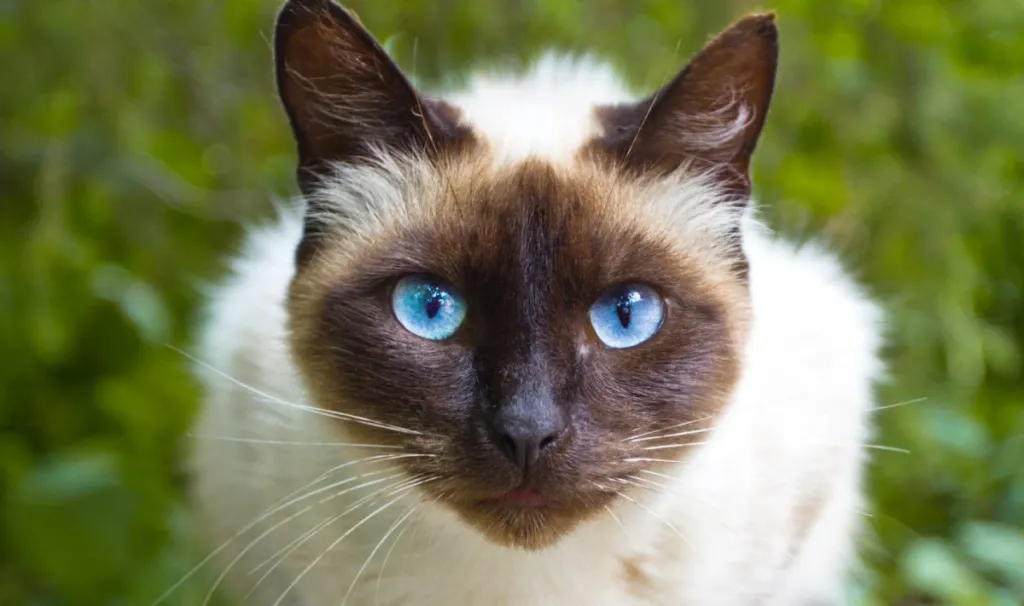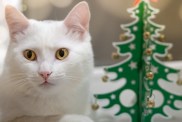Siamese cats are a beautiful breed known for their vivid blue almond-shaped eyes, short coat, and unique color-point pattern. Because this breed is social, the Siamese cat thrives in loving and interactive homes where their need for attention and mental stimulation is met. The Siamese cat personality is also known for their highly extroverted nature. To that end, don’t be surprised if these cats follow you around, boop their faces against yours, or engage in vocal chatter. These cats are very talkative!
Like many other cat breeds, they enjoy interactive play sessions and puzzles that challenge their minds. Sure, they have no problem spending time napping throughout the day, but they also need their sharp minds challenged. You’ll want to spend time playing with these kitties to keep them from getting bored. Because of their social nature, these cats often get along well with other pets and children. However, they can become anxious if left alone for long periods, so providing them with company and attention is crucial for their well-being.
When considering a Siamese cat, it’s advisable to prioritize adopting from rescue organizations or shelters to provide a loving home to a cat in need. However, if you decide to purchase a Siamese kitten, it’s crucial to choose a reputable breeder. Conduct thorough research to ensure that the breeder follows ethical practices and prioritizes the well-being of their cats. Reputable Siamese breeders prioritize the health and temperament of their cats. They also conduct necessary health screenings, and provide a nurturing environment for the kitties. This active approach ensures that you bring home a healthy and happy kitty while discouraging unethical breeding practices.
Quick Facts
- Origin: Thailand
- Size: Medium
- Breed Group: Oriental
- Siamese Cat Lifespan: 12-15 years
- Coat: Short and silky, adorned with distinctive color points on the face, ears, paws, and tail. Siamese cats come in a variety of hues, including Seal points, lilac points, blue points, and the elusive flame point. Black Siamese cats are exceptionally rare to come by. The unique “point” coloring arises from whats known as the Himalayan gene, causing cooler parts of the body to develop contrasting hues. It’s possible that a fully black Siamese cat may lack this distinctive mutation altogether.
- Temperament: Intelligent, playful, and affectionate
- Exercise Needs: Moderate
- Training: Easy to train
- Grooming: Weekly brushing
- Health: Generally healthy, but can be prone to certain genetic health conditions, such as hypertrophic cardiomyopathy (HCM) and strabismus.
- The Siamese cat typically has a short coat. If you believe you have a fluffy Siamese cat with long fur, it’s more likely that you actually have a Balinese cat.
- Sagwa, the Siamese Chinese cat, is an animated character featured in the children’s TV show “Sagwa.”
- They were originally known as “Wichien-matt,” which means “moon diamond” in Thai.
- Kittens are born entirely white and will gradually develop their distinctive color points over time. As they venture away from the warmth of the womb, the cooler parts of their bodies begin to take on coloration.
- A pair of Siamese cats thwarted espionage efforts by meowing and clawing at a wall within the Dutch Embassy, revealing hidden microphones concealed behind it.
Siamese Pictures
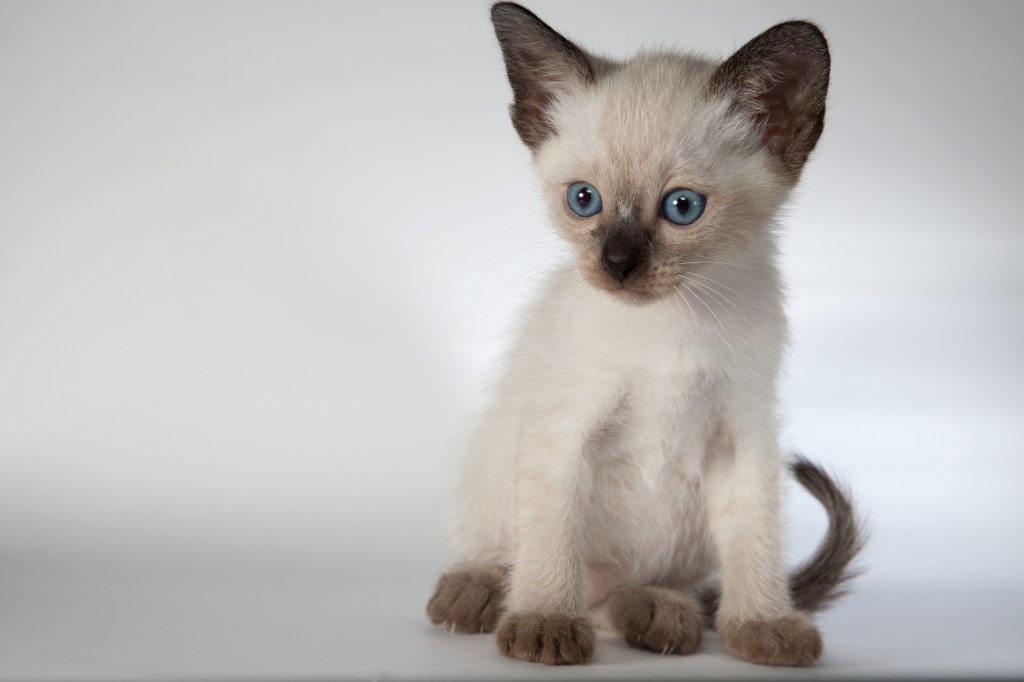

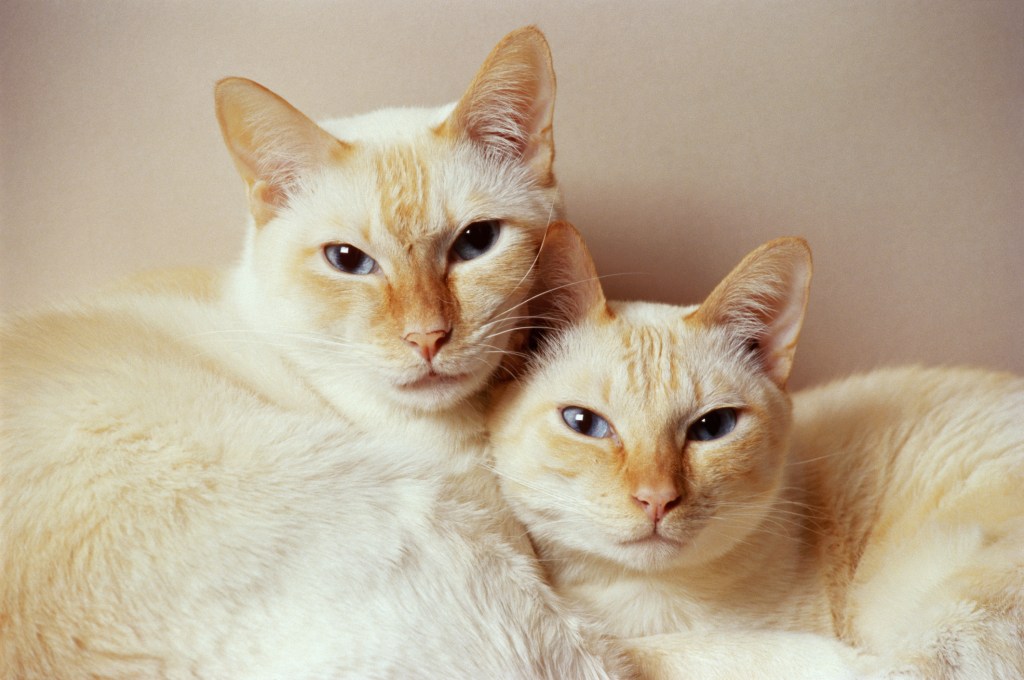
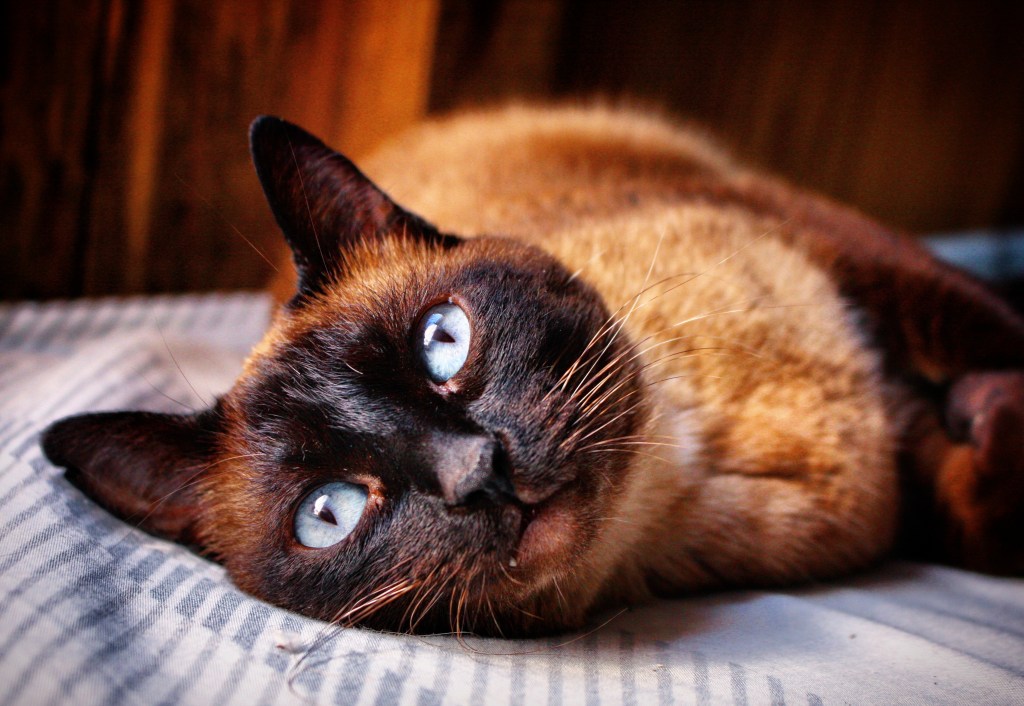
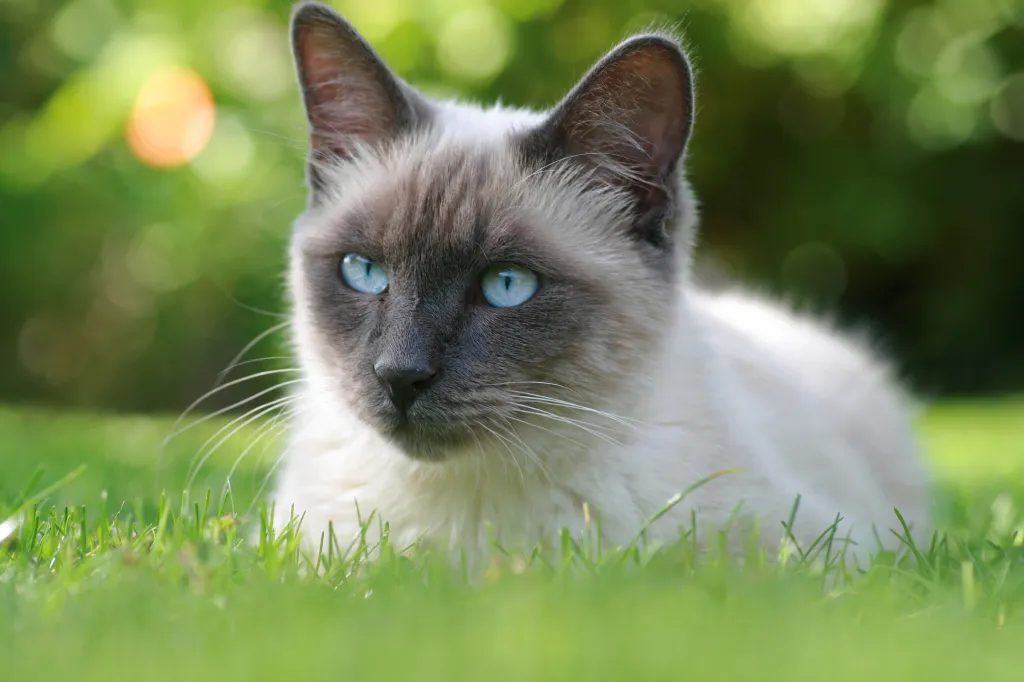
-
Affectionate with Family
Some cat breeds are typically independent and aloof, even if they’ve been raised by the same person since kittenhood; others bond closely to one person and are indifferent to everyone else; and some shower the whole family with affection. Breed isn’t the only factor that goes into affection levels; cats who were raised inside a home with people around feel more comfortable with humans and bond more easily.

See Cats Less Affectionate with Family -
Amount of Shedding
If you’re going to share your home with a cat, you’ll need to deal with some level of cat hair on your clothes and in your house. However, shedding does vary among the breeds. If you’re a neatnik, you’ll need to either pick a low-shedding breed or relax your standards. This furniture cover can make it easier to clean up cat hair and keep it off your sofa!
-
General Health
Due to poor breeding practices, some breeds are prone to certain genetic health problems. This doesn’t mean that every cat of that breed will develop those diseases; it just means that they’re at an increased risk. If you’re looking only for purebred cats or kittens, it’s a good idea to find out which genetic illnesses are common to the breed you’re interested in.
-
Potential for Playfulness
Some cats are perpetual kittens—full of energy and mischief—while others are more serious and sedate. Although a playful kitten sounds endearing, consider how many games of chase the mouse-toy you want to play each day, and whether you have kids or other animals who can stand in as playmates. A classic wand cat toy like this one is perfect for playful felines!
-
Tendency to Vocalize
Some breeds sound off more often than others with meows, yowls, and chattering. When choosing a breed, think about how the cat vocalizes and how often. If constant “conversation” drives you crazy, consider a kitty less likely to chat.
-
Kid-Friendly
Being tolerant of children, sturdy enough to handle the heavy-handed pets and hugs they can dish out, and having a nonchalant attitude toward running, screaming youngsters are all traits that make a kid-friendly cat. Our ratings are generalizations, and they’re not a guarantee of how any breed or individual cat will behave; cats from any breed can be good with children based on their past experiences and personality.
-
Easy to Groom
Some breeds require very little in the way of grooming; others require regular brushing to stay clean and healthy. Consider whether you have the time and patience for a cat who needs daily brushing. You should definitely pick up this awesome de-shedding tool for cats of any hair length!
-
Intelligence
Some cat breeds are reputed to be smarter than others. But all cats, if deprived the mental stimulation they need, will make their own busy work. Interactive cat toys are a good way to give a cat a brain workout and keep them out of mischief. This scratcher cat toy can keep your smart kitty busy even when you’re not home!
-
Pet Friendly
Friendliness toward other household animals and friendliness toward humans are two completely different things. Some cats are more likely than others to be accepting of other pets in the home.
Siamese History
The sophisticated Siamese looks dressed for an elegant masquerade ball in pale evening wear with chic black accessories and tanzanite-blue eyes. Cats with light-colored coats set off with black mask, ears, paws and tail have been known in Thailand (formerly Siam) for centuries. Ancient manuscripts depict the cats, but they were not seen in the West until the late nineteenth century, when they were exhibited at the Crystal Palace Cat Show in London.
Not everyone appreciated their unusual appearance, but they quickly became fashionable pets. By the turn of the century, if not earlier, they were popular in the United States as well. President Rutherford B. Hayes (1877-1881) and his wife Lucy were the recipients of a Siamese cat shipped to them in 1878 by David B. Sickels, a U. S. diplomat stationed at the consulate in Thailand. A letter from Sickels detailing the gift is on file at the Rutherford B. Hayes Presidential Center in Fremont, Ohio.
At first, only the cats with seal points—a dark brownish-black—were shown, but blue, chocolate and lilac-point Siamese were soon developed and accepted in the show ring. Today Siamese come in many different point colors and patterns, including tabby points and smoke points.
The Siamese itself is a natural breed, meaning its original pointed pattern was the result of a genetic mutation. The breed has contributed to the creation of many other breeds, including the Balinese, Oriental, the Himalayan division of the Persian, the Tonkinese and the Havana Brown.
The Siamese is recognized by all cat associations. The International Cat Association also recognizes the Thai, described as the original form of the native pointed cat of Thailand. In Thailand the cats are called Wichienmaat. Some people refer to it as an old-style Siamese. It shares the pointed coat and domineering personality of the Siamese but has a more moderate body type.
Siamese Size
Siamese cats are generally of medium size, with a slender and elegant build. Adult male Siamese cats typically weigh between 11-15 pounds, while adult females usually weigh between 8-12 pounds.
Siamese Personality
“We are Siamese if you please. We are Siamese if you don’t please.” Those lines, sung by two haughty Siamese cats in Disney’s Lady and the Tramp, express the Siamese personality perfectly. Perhaps the most important thing to know about these cats is they are talkative and opinionated. They will tell you exactly what they think, in a loud, raspy voice, and they expect you to pay attention and act on their advice.
Siamese cats are extremely fond of their people. They like to be “helpful” and will follow you around and supervise your every move. When you are sitting down, a Siamese will be in your lap, and at night he will be in bed with you, probably under the covers with his head on the pillow. Do not get a Siamese if living with a chatty busybody would drive you insane.
On the other hand, if you enjoy having someone to talk to throughout the day, the Siamese can be your best friend. Just be sure you have time to spend with this demanding and social cat. Siamese do not like being left alone for long periods, and if you work during the day it can be smart to get two of them so they can keep each other company.
The Siamese is highly intelligent, agile, athletic, and loves to play. Keep his busy brain active with puzzle toys and his body exercised with teaser toys he can chase and a big cat tree he can climb. Never leave him without any form of entertainment, or you will likely come home to find that he has reprogrammed your DVR to record only nature shows or at the very least decided your toilet paper rolls and tissue boxes look better empty.
Choose a Siamese cat if you look forward to spending time with and interacting with your cat. This is a loyal and loving feline who will pout and pine if given little or no attention. In the right home, however, he thrives for years.
Siamese Health
Both pedigreed cats and mixed-breed cats have varying incidences of health problems that may be genetic in nature. Problems that may affect the Siamese include the following:
- Amyloidosis: This is a disease that occurs when a type of protein called amyloid is deposited in body organs, primarily the liver in Siamese.
- Asthma: Asthma in cats, also known as feline bronchial disease or feline asthma, is a respiratory condition characterized by inflammation and constriction of the airways. It is a common condition in cats and can affect felines of any age or breed
- Congenital Heart Defects: Congenital heart defects in cats refer to abnormalities in the structure or function of the heart that are present at birth. These defects can vary in severity and may affect different parts of the heart. While some congenital heart defects may not cause significant health problems, others can lead to serious complications.
Siamese Care
The short, fine coat of the Siamese is easily cared for with weekly combing to remove dead hair and distribute skin oils. Brush the teeth to prevent periodontal disease. Daily dental hygiene is best, but weekly brushing is better than nothing.
It’s a good idea to keep a Siamese as an indoor-only cat to protect him from diseases spread by other cats, attacks by dogs or coyotes, and the other dangers that face cats who go outdoors, such as being hit by a car. Siamese who go outdoors also run the risk of being stolen by someone who would like to have such a beautiful cat without paying for it.
Siamese Coat Color And Grooming
What the Siamese looks like depends on the breed standard of each particular organization. Most cat associations call for the Siamese to have a svelte but muscular body with long lines. The wedge-shaped head is long and tapering from the narrow point of the nose outward to the tips of the ears, forming a triangle. The unusually large ears are wide at the base, pointed at the tip, giving them the same triangular shape as the head. Medium-size almond-shaped eyes are always a deep vivid blue.
The body is often described as tubular and is supported by long, slim legs, with the hind legs higher than the front legs. The Siamese walks on small, dainty, oval paws and swishes a long, thin tail that tapers to a fine point.
The short coat of the Siamese has a fine texture. In the Cat Fanciers Association, it comes in four colors: seal point, a pale fawn to cream body with deep seal brown points and deep brown nose leather and paw pads; chocolate point, an ivory body with milk chocolate-colored points and cinnamon-pink nose leather and paw pads; blue point, a bluish-white body with deep blue points and slate-colored nose leather and paw pads; and lilac point, a glacial white body with frosty pinky-gray points and lavender-pink nose leather and paw pads.
The International Cat Association allows for a range of colors beyond the four point colors recognized by CFA. They include tabby points, red points, cream points, silver tabby points, smoke points and particolor points. The Traditional Cat Association recognizes two types of Siamese, the Traditional and the Classic, both with a very different look than the modern Siamese recognized by CFA, TICA and other cat associations. The TCA’s Traditional Siamese has a round head and a big-boned, rounded body. The TCA’s Classic Siamese is also big-boned but has a slightly more elongated body than the Traditional Siamese and a wide wedge-shaped head. They come in the same four colors recognized by CFA, plus albino.
What about the Thai? The TICA breed standard calls for it to have modified wedge-shaped head of medium width with rounded cheeks and a muzzle that tapers to a rounded end, much like a tapered garden spade. The head is longer than it is wide, but not to an extreme degree. The eyes have a full almond shape and the ears are medium size to slightly large, with the tip pointing outward at a slight angle. The lithe, graceful body is moderately long but not tubular. Medium-length legs are graceful and are supported by medium-size oval-shaped paws. The tail is as long as the torso, tapering at the tip. The coat is short and silky with a pale, off-white body color and dense, even point colors.
Children And Other Pets
The active and social Siamese is a perfect choice for families with children and cat-friendly dogs. He will play fetch as well as any retriever, learns tricks easily and loves the attention he receives from children who treat him politely and with respect.
Siamese Rescue Groups
More Info For You
If you’re also looking for a dog, check out DogTime’s dog breed page!
